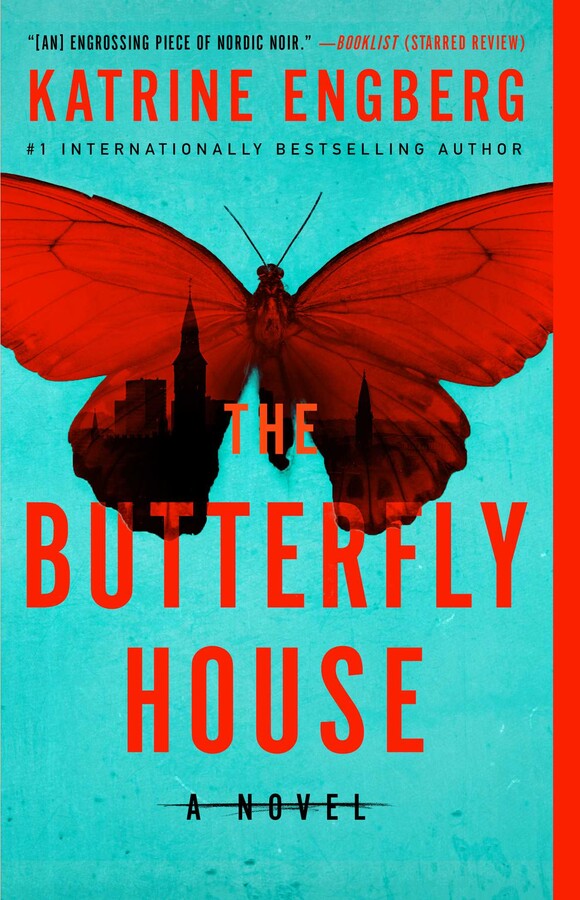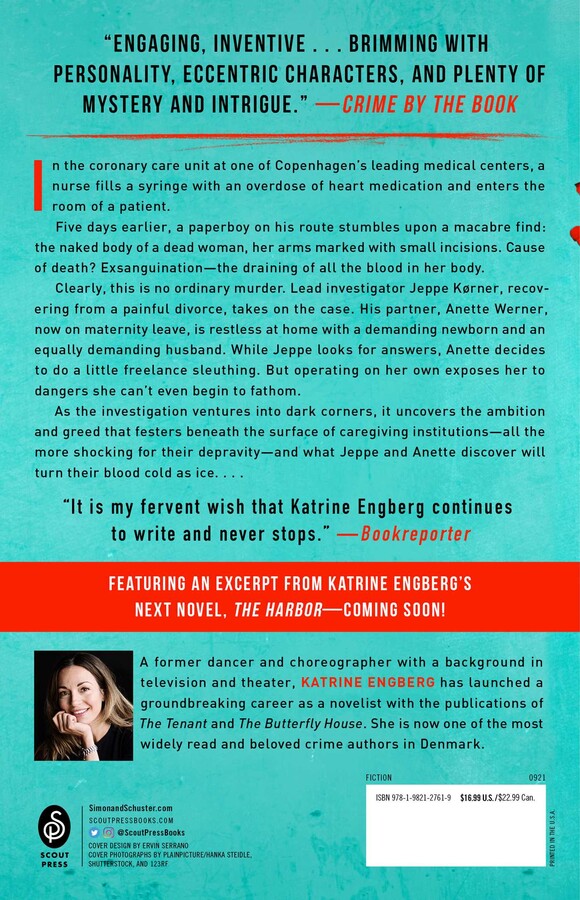The Butterfly House
LIST PRICE $16.99
Free shipping when you spend $40. Terms apply.
Buy from Other Retailers
Table of Contents
About The Book
Hospitals are supposed to be places of healing. But in the coronary care unit at one of Copenhagen’s leading medical centers, a nurse fills a syringe with an overdose of heart medication and stealthily enters the room of an older male patient.
Six days earlier, a paperboy on his route in central Copenhagen stumbles upon a macabre find: the naked body of a dead woman, lying in a fountain with arms marked with small incisions. Cause of death? Exsanguination—the draining of all the blood in her body.
Copenhagen investigator Jeppe Kørner, recovering from a painful divorce and in the throes of a new relationship, takes on the case. His partner, Anette Werner, now on maternity leave after an unexpected pregnancy, is restless at home with a demanding newborn and an equally demanding husband. While Jeppe pounds the streets looking for answers, Anette decides to do a little freelance sleuthing. But operating on her own exposes her to dangers she can’t even begin to fathom.
As the “thrillingly nerve-racking” (Shelf Awareness) investigation ventures into dark corners, it uncovers the shockingly depraved greed that festers beneath the surface of caregiving institutions—and what Jeppe and Anette discover will turn their blood as cold as ice…
Excerpt
The clear glass ampoules sat in the locked cabinet alongside disposable syringes and sharps containers—morphine and OxyContin for strong pain, Propafenone for atrial fibrillation, and the blood thinner Pradaxa, safely sealed in little boxes and wrapped in clear plastic: standard medications in the cardiology department at Copenhagen’s National Hospital, paths to relief and a better quality of life, sometimes even a cure.
The nurse cast a quick glance over the medications and did the calculations in her head. How heavy could he be? The patient’s weight was on the whiteboard at the head of his bed, but she was too exhausted to go check.
The night had dragged on forever. Just before her shift ended the day before, someone had called in sick and she had ended up pulling a double shift. Instead of spending an evening home with her family, she had worked for almost sixteen hours. Her brain was echoing with beeping alarms, requests, and questions from anxious patients. Her feet ached in the ergonomic shoes, and her neck felt stiff.
She yawned, rubbed her eyes, and caught her reflection in the shiny metal door of the medication cabinet. No thirty-two-year-old should have chronic bags under their eyes. This job was wearing her out. Just one hour left, then her shift would end, and she could go home and sleep while the kids got up and ate Coco Pops in front of the TV.
She selected three ampoules, put them in the pocket of her scrubs, and locked the cabinet behind her. Three 10 ml ampoules of 50 mg/ml ajmaline, that would be plenty. The patient couldn’t weigh more than 150 pounds or so, which meant that 30 ml of the anti-arrhythmia drug would be twice the recommended maximum dose. Enough to cause immediate cardiac arrest and release him from his suffering. And all the rest of us, she thought, setting off down the empty morning hallway toward room eight. The old man was demanding. He was foul-mouthed and rude, and complained about most things, from the weak hospital coffee to the doctors’ arrogance. The whole ward was tired of his cranky personality.
She had always been one to speak up and do something about a situation, not a role that makes one popular, but what else could she do? Stand idly by and complain about poor staffing ratios and the shortage of beds like her colleagues? No way! She had not become a nurse just to fetch coffee and bandage abrasions. She wanted to make a difference.
A cleaning lady, sporting a head scarf and a downcast expression, pushed her mopping cart down the hall without looking up from the linoleum floor. The nurse strode past her with the ampoules hidden in her pocket. Her heart rate sped up. Soon she would perform, live up to her full potential, and try to save a life. The anticipation started throbbing through her, as if it had a pulse of its own, a life to counterbalance the emptiness that normally filled her. In this moment, she would be indispensable. The stakes were high, so much rested on her shoulders. In this moment, she would be God.
She locked the door to the staff bathroom, quickly cleaned her hands and the countertop by the sink with alcohol, and laid out the ajmaline ampoules neatly side by side. With experienced fingers, she removed the disposable syringe from its packaging and drew the medicine up, flicking it per instinct to make sure it held no air bubbles. She crumpled the packaging up into a little ball and stuffed it down to the bottom of the trash can, then, with the syringe hidden in the pocket of her scrubs, she opened the door.
In front of room eight she cast a discreet glance down the hallway; no sign of colleagues or patients headed for the restroom. She pushed the door open and stepped into the darkness. A quiet snore from the bed told her the patient was asleep. She could work in peace.
She approached the bed, looking at the old man, who was lying on his back with his mouth open slightly. Gray, bony, and dried up with a little bubble of saliva at the corner of his mouth, his eyelids twitching ever so slightly. Is there anything, she thought, more superfluous in this world than grumpy old men?
She opened the cap of the venous catheter that adorned the thin-skinned back of his hand, and drew the syringe from her pocket. Direct access to the blood that flows to the heart, an open gateway for God’s outstretched fingertip.
The good thing about ajmaline is that it is fast acting; the cardiac arrest would occur almost instantaneously. She connected the syringe to the catheter, knowing she would just have time to hide the syringe before the monitor alarm was activated.
The patient moved a little in his sleep. She gently stroked his hand. Then she pushed the plunger all the way down.
Product Details
- Publisher: Gallery/Scout Press (August 31, 2021)
- Length: 368 pages
- ISBN13: 9781982127619
Raves and Reviews
Praise for The Butterfly House
“A second engrossing piece of Nordic noir, after the best-selling The Tenant (2020), from Engberg, who brings skills acquired as a dancer and choreographer to her writing. There is not one misstep, not one moment or movement out of sync...Once again, Engberg’s two detectives are impeccably defined, especially postpartum Anette, and a host of supporting characters are also sensitively portrayed. The theme is troubling yet timely.”—Booklist (starred review)
“Well-crafted . . . By addressing the issue of society’s treatment of the mentally ill, Engberg brings the complexities of life into this superior Danish police procedural. Fans of Scandinavian noir will hope this series has a long run.”—Publishers Weekly
“Original and absorbing. [Katrine Engberg] is a name to look out for.” -- The (London) Times
"Engberg has crafted a fine police procedural. She is an author to look out for, one who will be cited years hence as a key player in Nordic noir.”—BookPage
"Satisfying...[It] will please fans of police procedural."—Kirkus Reviews
"Taps into the fear of every civilized nation that its lauded health care system might be leaning toward inhumane end-of-days medical practices. The philosophical issues are worth debating."—The New York Times Book Review
“I loved The Butterfly House, and would highly recommend this engaging, inventive Danish crime novel for fans of Nordic Noir and police procedurals . . . brimming with personality, eccentric characters, and plenty of mystery and intrigue.”—Crime by the Book
"It is my fervent wish that Katrine Engberg continues to write and never stops."—Bookreporter
“Engberg isn’t sentimental or preachy—Tara Chace’s translation keeps the tone lively and colloquial—but she is insightful about why people act as they do, making this an unusually rich police procedural.”—Air Mail
"Finely wrought...Like The Tenant, The Butterfly House makes terrific use of its setting's cultural institutions and social mores. The novel's roaming perspective has a thrillingly nerve-racking effect: each time the viewpoint shifts, readers can't help but wonder if this is the character who's going to get it—or give it."—Shelf Awareness
"Brazen and original...[with] stellar sleuthing."—The Toronto Star
PRAISE FOR THE TENANT
"A stunning debut. Katrine Engberg’s unforgettable characters and brilliant plot twists will captivate readers of suspense fiction.”
– Kathy Reichs, #1 New York Times bestselling author
“What a fantastic debut! I love the characters, the sparkling prose, and the depiction of Copenhagen. Katrine Engberg is an absolute star!”
– Camilla Läckberg, #1 internationally bestselling author
“Engberg's fast-paced narrative is bolstered by an interesting and quirky cast as well as an intriguing setting . . . a lot of fun.”
– Kirkus Reviews
“Everyone has secrets, and some secrets are lies. Engberg's debut novel, a sleeper hit in her native Denmark, is sure to attract comparisons to other Scandinavian thrillers… layered, character-driven suspense from authors including Erin Kelly and Ruth Ware may prove to be more apt read-alike suggestions.”
– Booklist
"Fast-moving . . . Engberg’s sparkling cast and palpable evocation of a society U.S. readers will find similar yet foreign keep the pages turning pleasurably."
– Publishers Weekly
"Engberg’s debut features dark family secrets—and a smorgasbord of surprises.”
– People
"[A] gripping addition to the Scandinavian crime fiction pantheon."
– OprahMag.com
"The careful plotting ensures that the mystery unfolds deliberately, with surprises constantly woven into the narrative . . . Engberg’s English language debut promises a gritty, unflinching procedural series, and will leave readers craving the translation of Kørner and Werner’s next adventure.”
– BookPage
"Winter wouldn't be complete without a great Nordic Noir novel, and that's exactly what Katrine Engberg's The Tenant is.”
– Bustle
"It’s hard to believe this is her [Engberg's] first book, so assured is the writing. Her characters are fully realized...[and] the story is as complex as the characters. Originally published in Denmark in 2016, The Tenant is Engberg’s first book to be translated into English, but it’s unlikely to be the last."
– Air Mail
"Engberg's plotting is dexterous, and her character-centered storytelling aligns nicely with her unhurried descriptions of Copenhagen . . . The Tenant is yet another feather in the plumed cap of Scandinavian noir."
– Shelf Awareness
Resources and Downloads
High Resolution Images
- Book Cover Image (jpg): The Butterfly House Trade Paperback 9781982127619
- Author Photo (jpg): Katrine Engberg Photograph by Les Kaner(0.1 MB)
Any use of an author photo must include its respective photo credit






